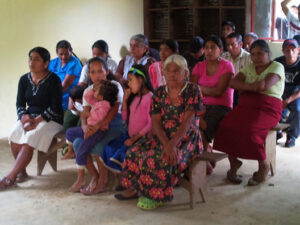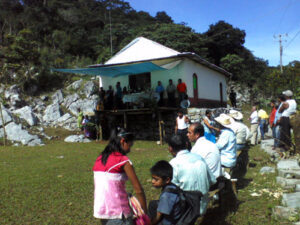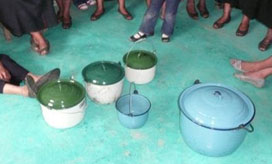Stories of Success

Because of their widespread potential, our pilot (Gen1) cookstove program received an award from the Licensing Executive Society of the World Patent Office.
Self-reliance and demand are measures of success. Since introducing our La Mazateca eco-cookstoves, there has been a pent-up demand in Oaxaca & Chiapas.
- In 2015, The Hunger Project – Mexico worked with the communities in Oaxaca, to procure funding to build more cookstoves.
- Using these funds, the 14 stove builders we trained in Oaxaca constructed 49 Gen1 stoves, their first attempt in banning together as business partners.
- Communities in Chiapas have also decided to move forward and are now raising the funds needed to built 279 Gen1 stoves.
- San Luis Potosì, after hearing about La Mazateca cookstoves and visiting Oaxaca to check them out, decided to build six in their communities to evaluate.
- The stove builders we trained in Oaxaca have become the “experts”, have built pilot stoves and have trained additional stove builders in Oaxaca, Chiapas and San Luis Potosí.
- Because demand is higher than funding, community leaders have had to hold meetings to prioritize household users with the most dire need.
In the future, we hope to partner with our stove builders to meet every household’s efficient cooking needs.
- There are now 175 stoves that have been built in Southern Mexico and are in production.
- The average cooking time for a meal has gone from 2 hours and 40 minutes to 1 hour.
What do our users have to say?
- “The new stove makes cooking faster and better. It requires less time and effort [blowing] than cooking on a three stone fire.” Agripina Martinez Vasquez (recipient of Gen1 test stove)
- “I’m very happy with my new stove. I can cook tortillas faster. The comal gets hotter faster and with less wood than the three stone fire I used to use.” Julia Venegas Carbagal (recipient of Gen1 test stove)
- “With one small fire, I can now cook tortillas and make coffee (and keep it hot) at the same time. I used to worry about burning the tortillas, but now I can control the comal heat
so they don’t burn.” Virginia Pantoja Garcia (recipient of Gen1 test stove)
[ngg_images source=”galleries” container_ids=”1″ display_type=”photocrati-nextgen_basic_thumbnails” override_thumbnail_settings=”0″ thumbnail_width=”240″ thumbnail_height=”160″ thumbnail_crop=”1″ images_per_page=”20″ number_of_columns=”0″ ajax_pagination=”0″ show_all_in_lightbox=”0″ use_imagebrowser_effect=”0″ show_slideshow_link=”1″ slideshow_link_text=”[Show slideshow]” order_by=”sortorder” order_direction=”ASC” returns=”included” maximum_entity_count=”500″]
How does culture influence our designs? Water for Humans makes sure that local conditions, culture, preferences, and practical concerns are all taken into consideration in our design, engineering, and building processes. For our cookstoves:
- We build cooking surfaces that accommodate typical indigenous cookware.
- Our stove size is adjusted for typical village household kitchens.
- At user’s requests, our new stove height allows women to sit while cooking.
- Our design uses reduced parts compared to other cookstoves so less material needs to be carried on treacherous mountain paths between villages.


Comales made of clay or steel? Comales are a very important part of the cookstove. This is where women make tortillas daily to feed their families. A comal made of clay has the advantage of staying a constant shape (no warping!) and being very light. But clay comales chip and break easily. A steel comal is very hardy and does not break into pieces, but it can warp or bend more quickly. What do we make our comales out of? In Oaxaca, women prefer steel comales. In Chiapas, women prefer clay.
Our stove design allows for either clay or steel, depending on women’s preferences!
Why are these pots significant? Women in Chiapas discussed what size pots they would most want to use on the new stove. After women tried out several pots, they came to a decision that enabled us to modify the stove top design to accommodate their preferred pot sizes. We consider who is using our stoves, what they are cooking, and a community’s cultural needs.


